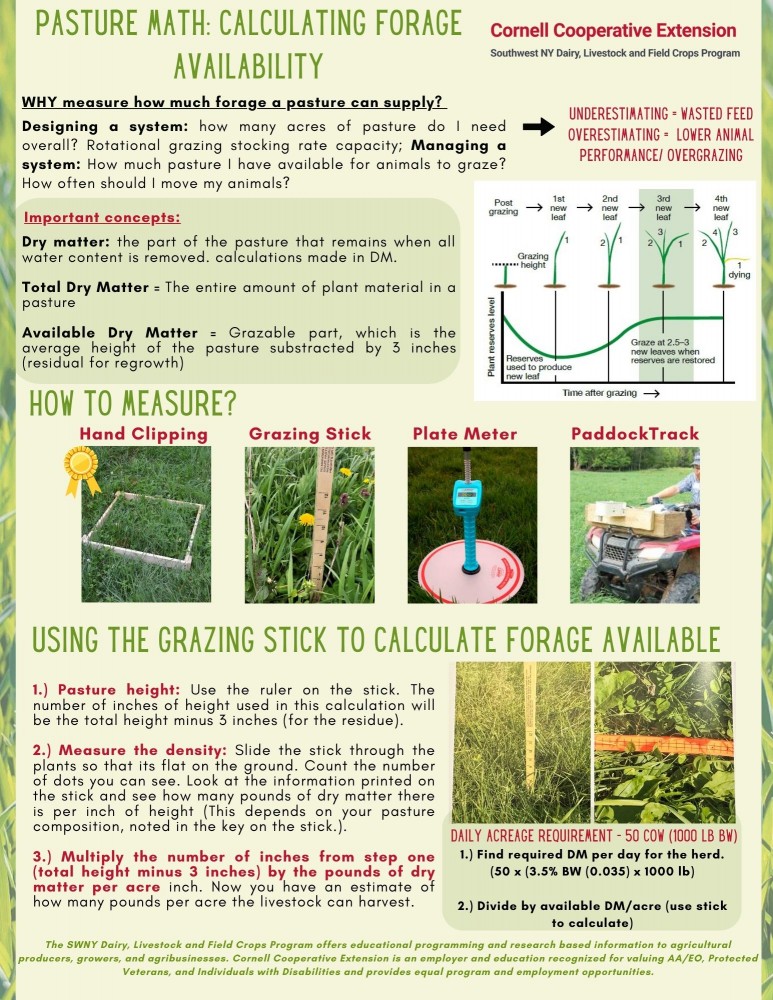Mastering Pasture Management with Grazing Stick: A Pro Farmer's Tool for Success
Camila Lage, Dairy Management Specialist
Southwest New York Dairy, Livestock and Field Crops Program
Mastering Pasture Management with Grazing Stick: A Pro Farmer's Tool for Success
The grazing stick is a valuable tool for farmers to measure pasture dry matter and estimate the available forage for their livestock. Its importance lies in providing a quick, practical, and calibrated measurement system to assess the grazing potential of a pasture. While using the grazing stick, it's essential to take multiple samples from various areas to ensure a representative value of the pasture's dry matter. This helps account for variations in the pasture's growth and grazing potential.
How to Use a Grazing Stick:
Measure Total Forage Height: Use the ruler on the grazing stick to measure the total height of the forage. Subtract 3 inches from the total height to account for residual forage that should not be considered grazable material. To accurately gauge the average leaf height of the grass in trampled vegetation, hold the foliage upright in one hand, excluding stems and seed heads of tall grasses from the measurement for precise results. A good rule of thumb for large pastures is that grazing stick measurements should be taken at least 15-to-20 locations within a pasture. In smaller pastures, 7-10 measurements may give you an accurate measurement.
Measure Density: Slide the grazing stick through the plants, keeping it flat on the ground at the soil surface. Observe the number of dots visible on the stick, which corresponds to the pounds of dry matter per inch of height.
Calculate Estimated Harvest: Multiply the number of inches from step one (total height minus 3 inches) by the pounds of dry matter per acre inch. This calculation estimates how many pounds per acre the livestock can harvest.
Using the grazing stick help farmers have an accurate understanding of the available dry matter in their pastures. This knowledge is crucial for proper pasture management, preventing wastage of feed, and avoiding situations where the livestock may suffer from insufficient forage. By implementing short grazing and adequate recovery periods, farmers can successfully maintain a healthy grazing system that benefits both the livestock and the pasture's overall health.
For assistance and guidance on how to get and use grazing sticks effectively, contact Camila Lage at 607-422-6788 or cd546@cornell.edu
You can also contact your local NRCS (Natural Resources Conservation Service) office for a grazing stick. They also provide resources and support to farmers for sustainable pasture management and grazing practices.

PDF Grazing Stick Handout (pdf; 6568KB)
Upcoming Events
WEBINAR - Automated Milking Systems Efficiency: Balancing Focus on Individual Cows and System Optimization
May 8, 2024
Please join Cornell the SWNY team and MSU Extension for our talk with Dr. Pablo Silva Boloña on improving efficiency of Automated milking systems by focusing on milking settings for individual and group success.
Broiler Field Day at Sunny Cove Farm
June 6, 2024
Alfred Station, NY
Join us for a field day to explore broiler production, processing, and finances. Meghan Snyder of Sunny Cove Farm will be our host. She raises small batches of organic broilers, processing them on-farm under the 1,000 bird exemption.
Cornell Seed Growers Field Day
July 2, 2024
Ithaca, NY
Please Save the Date for the Cornell Seed Growers Field Day to be held the morning of July 2nd. The event will be held at the NYSIP Foundation Seed Barn, 791 Dryden Rd., Rt. 366, Ithaca, NY.
Announcements
No announcements at this time.





